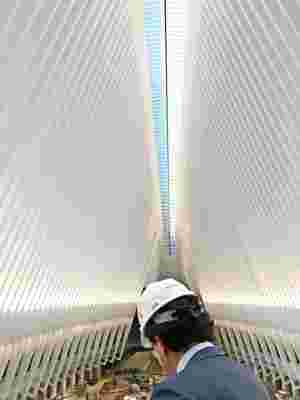Santiago Calatrava on the World Trade Center Transportation Hub
From bridges for a World Expo in Spain to a tower that twists in Sweden , architect Santiago Calatrava has built a reputation for creating structures so dynamic, they appear poised to take flight at any moment. Which is why he was tapped to design the World Trade Center Transportation Hub, a project that would prove difficult for its symbolism, its physical complexity, as well as for the number of commuters it would need to accommodate. We visited Calatrava, winner of the 2015 European Prize for Architecture , in his Manhattan home to discuss the themes that went into the construction of his most recent New York City project.
Architectural Digest: What was your initial inspiration for designing the World Trade Center Transportation Hub?
Santiago Calatrava: My family purchased a home in New York after the events of September 11. When I began to design the concept, my inspiration was rooted in the feeling permeating through the streets of New York during that tragic moment in history. A part of us was feeling dead inside, yet we knew we had to persevere, to push forward. With this in mind, I had the deepest desire to build something exceptional, something that had the calming sense of peace and hope for future generations who walk through the space.
AD: Did you look at other specific buildings when you began brainstorming concepts?
SC: I had previously built several railway facilities throughout Europe, so I had strong background in the subject. Yet, as you can imagine, this project in Lower Manhattan was more complex. The emotional components, the cultural significance of the place all made the project more demanding. So I had to search for some inspiration. And that came from two of my favorite buildings: Grand Central Terminal and the old Pennsylvania Station. These two structures are grand in scale, but not because they needed to be. When Grand Central and Penn were built, trains were running with electricity instead of steam, like those iconic stations in Europe. So, it became evident that these two train terminals in New York were boldly built as an excuse to create wonderful civic monuments and breathtaking spaces for the people. If you look, there are few cases, even worldwide, where you can create those spaces just to gather people. Maybe with cathedrals? But train stations—that’s very rare.
AD: So you wanted to capture a different feeling with this transportation hub, as opposed to others you’ve designed?
SC: Yes, I wanted to celebrate New York City, and those people who work so hard in it every single day. I built it to such a scale for those daily commuters. Maybe they live in very modest apartments, or work in a small cubicle. I want for them to suddenly arrive to the station by train and, twice a day, for ten minutes or so, stand before an immaculately fashioned station that was built just for them. I want for them to enjoy it, to feel important and part of something bigger, more grand.

The interiors are meant to evoke the monumental feeling of a cathedral. An image of Calatrava looking over the Oculus.
AD: Now, a more practical question. How do you make a space this vast, which connects so many trains, easy to navigate?
SC: I have always said, “I will build a station that my mother can find her way around very easily and comfortably.” Why? Because finding one’s way in a station is essential. The idea of going down into the ground through long escalators, entering dim places, this is our everyday life in New York. But does it have to be so dark? I wanted to create a place that delivers the people a sense of comfort through its orientation, while also delivering a sense of security by opening everything to the naked eye.
AD: There has been a lot of buzz surrounding the retractable skylight roof. What was your reasoning in creating this?
SC: My intention was for the commuters to always have a view of the sky. Visitors can see the morning light, as it rises along Fulton Street, on their daily commute. This, “wedge of light,” as named by Daniel Libeskind, should be very special to witness. The idea of placing this gap there, to see the sky and to bring in bright light is, for me, very symbolic.